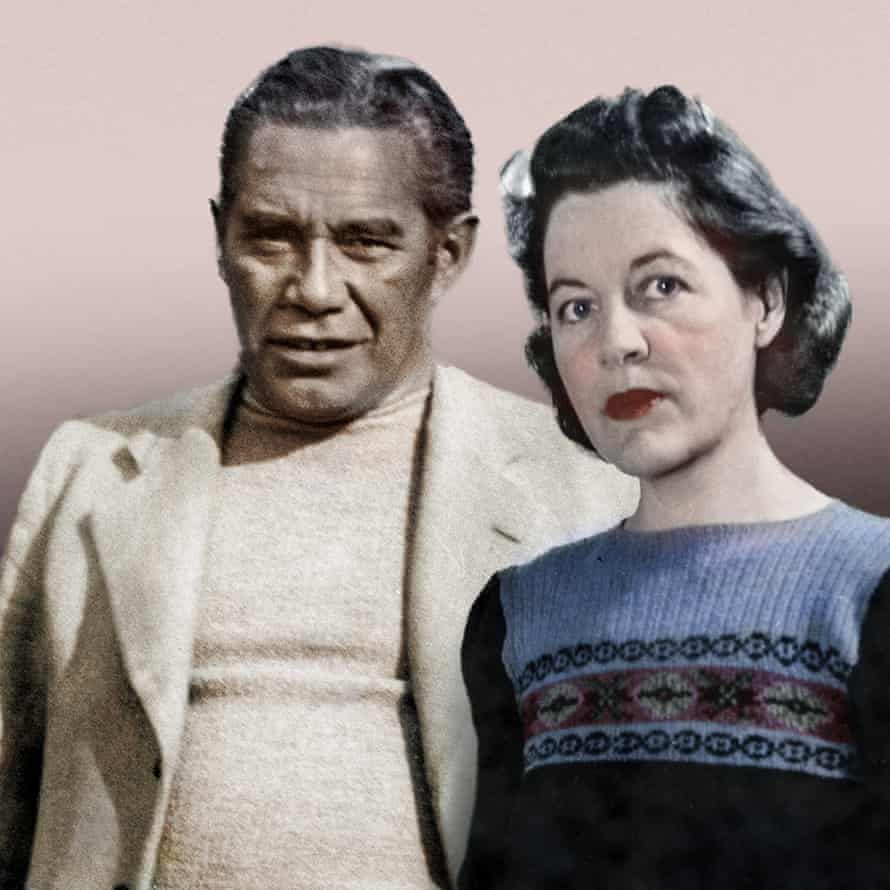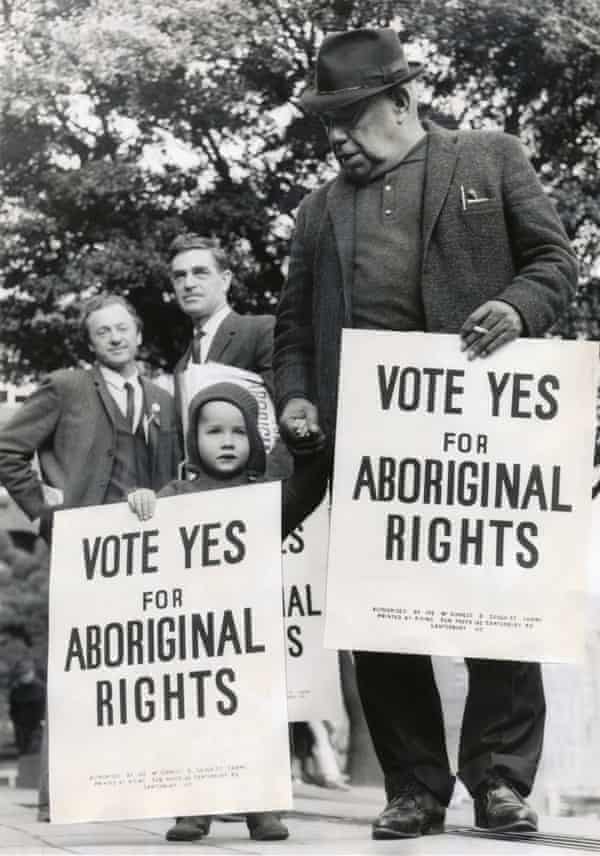The late Wiradjuri and Yorta Yorta activist William Townsend “Bill” Onus Jr was a larger-than-life activist, boomerang champion and theatrical entrepreneur.
But Onus might also have become as famous for the cinematic portrayal of the plight of his people, had his documentary film work ever seen the light of day.
In 1939, Bill Onus was a leader of the Aboriginal mass strike at Cummeragunja in New South Wales, the reserve he was born on, in 1906. Ten years after his birth, he fled with his mother and siblings, after they were warned welfare would take children away. Towards the end of his life, he was a key campaign figure in the successful 1967 referendum that amended the constitution to count Indigenous people as Australian citizens for the first time.
“Ongoing mythologies have sprung up around Bill,” says his grandson Tiriki Onus. Born 12 years after Bill’s 1968 death, Tiriki would be “constantly told growing up how much I looked like him”; one aunt even approvingly informed him he had a “Bill-shaped head”. A bass-baritone, Tiriki was cast by Deborah Cheetham to play his grandfather in the 2010 opera, Pecan Summer.
Tiriki knew his grandfather made films, but had no idea to what depth and extent. One day, he was rifling through an old suitcase in his mother’s basement, which contained photographs of Bill – including some taken by Bill’s wife, Mary, who had married Bill against her wealthy white family’s wishes. One photo showed three Aboriginal boys in ceremonial paint looking at a Bell and Howell 32mm movie camera, on location in Heidelberg, Melbourne, in 1946.
Some time later the film-maker Alec Morgan, known for the 1983 documentary Lousy Little Sixpence, rang Tiriki to introduce himself, and to ask: “Do you know your grandfather was the first Aboriginal film-maker?” Onus replied: “I know he filmed stuff, but all those films were burned, they were lost.”
Morgan countered: “I’ve found this film in the archives that I think belonged to Bill.”
While Bill Onus had appeared as an extra in Charles Chauvel’s Uncivilised of 1936 and Harry Watt’s The Overlanders a decade later (gaining little credit for his cultural advisory role with Watt), family lore held that he had also made his own films, which had been destroyed in a caravan fire in the late 1950s. Tiriki is unsure of the films’ content, but there were stories of him filming proceedings of “significant meetings of Aboriginal activists up and down the east coast”.
Now here was a black-and-white silent film, rediscovered in a tin at the National Film and Sound Archive, which some bygone archivist had simply marked “Aborigines in the community” – showing the same boys from the suitcase photos dancing around a gum tree and Bill throwing a boomerang, recalling his youth performing in a travelling show.
The story of this rediscovered, though untitled, nine-and-a-half minute piece of postwar footage – footage from a possibly longer documentary, or a newsreel film – is told in Alec Morgan and Tiriki Onus’s documentary Ablaze, which will premiere at the Melbourne international film festival in August.
The rediscovered film also shows Tiriki’s great-aunt Wynne and great-uncle Eric acting in a dance drama called White Justice in 1946 at the New Theatre in Flinders Street, Melbourne, in which Aboriginal performers reenacted the Pilbara strike of hundreds of Aboriginal pastoral workers earlier that year.
At one point, the stage performers are chained to one another by the neck, which Bill Onus himself reported seeing while filming The Overlanders in northern Australia that same decade. Other scenes were filmed in slum terraces of Fitzroy, and on a Melbourne tram.
Sign up for the fun stuff with our rundown of must-reads, pop culture and tips for the weekend, every Saturday morning
Tiriki Onus and Alec Morgan saw the strong political nature of Bill Onus’s film-making. It was clear Bill wanted to take his film to a cinema audience, to tell the story of Indigenous Australians’ impoverished lives and fight for equal rights. They learned he had even lined up a deal with a distribution company for a theatrical release.
“He was directing stuff designed to function in a very specific way for the causes he was fighting for,” says his grandson. “This wasn’t a hobby; this was a powerful tool in Bill’s arsenal.”
The documentary postulates that political pressure was applied to the film company to drop Onus’s film, for which he had likely recorded a voiceover narrative that is now lost. His activism and his 1947 marriage to Mary McLintock Kelly, whom he met at a Communist party rally, attracted the attention of Australia’s security agencies: Mary was a party member, although Onus was not.

Later, when Onus wanted to travel to the United States to speak about the Indigenous Australian plight as part of the burgeoning US civil rights movement, his passport was suddenly cancelled. The Australian Security Intelligence Organisation, it transpired, had handed his surveillance file to the US embassy.
“There’s solid evidence for the cancelling of the passport, and for the things being done to suppress Bill,” says Tiriki. “This is one of the great gifts that Asio has given us: they kept really good records … Bill has got a weighty Asio tome.”
Onus pursued Indigenous equality by other means. In 1951, for instance, he helped produce and performed in the successful Out of the Dark: an Aboriginal Moomba at Melbourne’s Princess Theatre – groundbreaking for using Indigenous performers in an era of blackface. He established a shop in the Dandenong Ranges in which he sold boomerangs and other souvenirs, drawing visitors by demonstrating his boomerang skills.

But Onus was soon drawn back to the city for one final campaign, lending his elder status to the yes campaign for the 1967 referendum, by this time as the first Aboriginal president of the Aborigines Advancement League, as well as its representative on the Victorian Aborigines Welfare Board. Onus lived to see 90.77% of Australians vote in support of Indigenous people being included in the national census, and to allow the federal government to make laws that included Aboriginal people. He died of a coronary occlusion in 1968, age 61.
Can he be definitively called Australia’s first Aboriginal film-maker?
“As the record stands at the moment, yes it would seem that Bill is the first Aboriginal film-maker,” says Tiriki Onus, who sings the Yorta Yorta-language song Ngarra Burra Ferra while cloaked in possum skin at the end of documentary.
“But it doesn’t particularly excite or interest me that much, the idea of [his] being first. What really does excite me is the way that [his legacy] has grown – the fact that now here I am as his grandson, 70 years later, being able to tell his story, to carry on in his footsteps.
“There’s something exciting for me about being in much broader company like that, to be a grain of sand on the beach.”